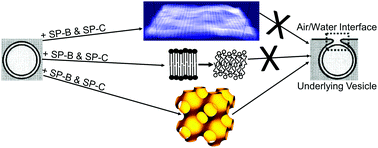Changes in membrane elasticity caused by the hydrophobic surfactant proteins correlate poorly with adsorption of lipid vesicles
Abstract
To establish how the hydrophobic surfactant proteins, SP-B and SP-C, promote adsorption of lipids to an air/water interface, we used X-ray diffuse scattering (XDS) to determine an order parameter of the lipid chains (Sxray) and the bending modulus of the lipid bilayers (KC). Samples contained different amounts of the proteins with two sets of lipids. Dioleoylphosphatidylcholine (DOPC) provided a simple, well characterized model system. The nonpolar and phospholipids (N&PL) from extracted calf surfactant provided the biological mix of lipids. For both systems, the proteins produced changes in Sxray that correlated well with KC. The dose–response to the proteins, however, differed. Small amounts of protein generated large decreases in Sxray and KC for DOPC that progressed monotonically. The changes for the surfactant lipids were erratic. Our studies then tested whether the proteins produced correlated effects on adsorption. Experiments measured the initial fall in surface tension during adsorption to a constant surface area, and then expansion of the interface during adsorption at a constant surface tension of 40 mN m−1. The proteins produced a sigmoidal increase in the rate of adsorption at 40 mN m−1 for both lipids. The results correlated poorly with the changes in Sxray and KC in both cases. Disordering of the lipid chains produced by the proteins, and the softening of the bilayers, fail to explain how the proteins promote adsorption of lipid vesicles.



 Please wait while we load your content...
Please wait while we load your content...